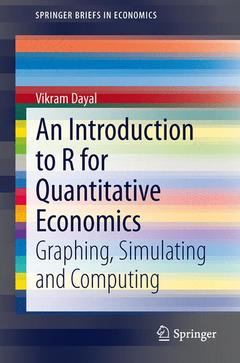An Introduction to R for Quantitative Economics, 2015 Graphing, Simulating and Computing SpringerBriefs in Economics Series
Auteur : Dayal Vikram

Vikram Dayal is an Associate Professor at the Institute of Economic Growth, Delhi. He is the author of the book titled The Environment in Economics and Development: Pluralist Extensions of Core Economic Models, published in the SpringerBriefs in Economics series in 2014. In 2009 he co-edited the Oxford Handbook of Environmental Economics in India with Professor Kanchan Chopra. He has been incorporating the use of software in teaching quantitative economics—his open access notes on Simulating to understand mathematics for economics with Excel and R are downloadable at http(colon)(double back slash)textbookrevolution(dot)org. His research on a range of environmental and developmental issues from outdoor and indoor air pollution in Goa, India to tigers and Prosopis juliflora in Ranthambhore National Park has been published in a variety of journals. He visited the Workshop in Political Theory and Policy Analysis in Bloomington, Indiana as a SANDEE (South Asian Network for Development and Environmental Economics) Partha Dasgupta Fellow in 2011. He studied economics in India and the USA and did his doctoral degree from the University of Delhi.
Date de parution : 03-2015
Ouvrage de 109 p.
15.5x23.5 cm
Thèmes d’An Introduction to R for Quantitative Economics :
Mots-clés :
Applied Econometrics; Quantitative Economics; R Software; Simulation; Visualizing Data



